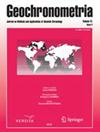Optically stimulated luminescence techniques applied to the dating of the fall of meteorites in Morasko
IF 0.9
4区 地球科学
Q3 Earth and Planetary Sciences
引用次数: 1
Abstract
Abstract Geological materials used for luminescence dating and associated with the fall of meteorites on the Earth’s surface are extremely rare. The Morasko region has gained fame over the past 100 years because of a cosmic catastrophe which took place there. After thousands of years, the remains of a large metal meteorite which fell in this area have been found. In this article, we would like to state whether it is possible, using luminescence methods, to determine the moment when the iron meteorite fell on the surface of the Earth. The material which was analysed consisted of meteorite crust layers – melt/fusion and “semi melt/fusion”, including sintered ones, along with the sediments surrounding the meteorite. The final results are connected with four objects of different sizes (large ones and small shrapnel – 261 kg, 34 kg, 970 g and 690 g). The obtained results show a large discrepancy, which is most likely associated with the problem of resetting the luminescence signal of the tested materials.光学刺激发光技术应用于莫拉斯科陨星的年代测定
用于发光测年和与地球表面陨星坠落有关的地质材料极为罕见。在过去的100年里,莫拉斯科地区因在那里发生的一场宇宙大灾难而名声大噪。几千年后,一块落在这个地区的大型金属陨石的残骸被发现了。在这篇文章中,我们想说明是否有可能使用发光方法来确定铁陨石落在地球表面的时刻。被分析的物质包括陨石外壳层——熔融/熔融和“半熔融/熔融”,包括烧结层,以及陨石周围的沉积物。最后的结果与四个不同尺寸的物体(大弹片和小弹片- 261 kg, 34 kg, 970 g和690 g)相关联,得到的结果有很大的差异,这很可能与被测材料的发光信号重置问题有关。
本文章由计算机程序翻译,如有差异,请以英文原文为准。
求助全文
约1分钟内获得全文
求助全文
来源期刊

Geochronometria
地学-地球科学综合
CiteScore
2.20
自引率
0.00%
发文量
1
审稿时长
>12 weeks
期刊介绍:
Geochronometria is aimed at integrating scientists developing different methods of absolute chronology and using them in different fields of earth and other natural sciences and archaeology. The methods in use are e.g. radiocarbon, stable isotopes, isotopes of natural decay series, optically stimulated luminescence, thermoluminescence, EPR/ESR, dendrochronology, varve chronology. The journal publishes papers that are devoted to developing the dating methods as well as studies concentrating on their applications in geology, palaeoclimatology, palaeobiology, palaeohydrology, geocgraphy and archaeology etc.
 求助内容:
求助内容: 应助结果提醒方式:
应助结果提醒方式:


